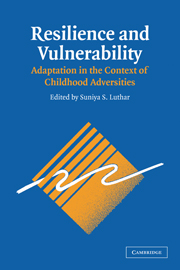Book contents
- Frontmatter
- Contents
- List of Contributors
- Foreword by Dante Cicchetti
- Preface
- 1 A Resilience Framework for Research, Policy, and Practice
- PART I FAMILIAL ADVERSITIES: PARENTAL PSYCHOPATHOLOGY AND FAMILY PROCESSES
- 2 Young Children with Mentally Ill Parents: Resilient Developmental Systems
- 3 Risk and Protective Factors for Children of Depressed Parents
- 4 Resilience and Vulnerability among Sons of Alcoholics: Relationship to Developmental Outcomes between Early Childhood and Adolescence
- 5 Maternal Drug Abuse versus Other Psychological Disturbances: Risks and Resilience among Children
- 6 Resilience to Childhood Adversity: Results of a 21-Year Study
- 7 Sequelae of Child Maltreatment: Vulnerability and Resilience
- 8 Risk and Resilience in Children Coping with Their Parents' Divorce and Remarriage
- 9 Correlational and Experimental Study of Resilience in Children of Divorce and Parentally Bereaved Children
- PART II EXOSYSTEMIC AND SOCIODEMOGRAPHIC RISKS
- PART III COMMENTARIES
- Index
- References
6 - Resilience to Childhood Adversity: Results of a 21-Year Study
Published online by Cambridge University Press: 05 June 2012
- Frontmatter
- Contents
- List of Contributors
- Foreword by Dante Cicchetti
- Preface
- 1 A Resilience Framework for Research, Policy, and Practice
- PART I FAMILIAL ADVERSITIES: PARENTAL PSYCHOPATHOLOGY AND FAMILY PROCESSES
- 2 Young Children with Mentally Ill Parents: Resilient Developmental Systems
- 3 Risk and Protective Factors for Children of Depressed Parents
- 4 Resilience and Vulnerability among Sons of Alcoholics: Relationship to Developmental Outcomes between Early Childhood and Adolescence
- 5 Maternal Drug Abuse versus Other Psychological Disturbances: Risks and Resilience among Children
- 6 Resilience to Childhood Adversity: Results of a 21-Year Study
- 7 Sequelae of Child Maltreatment: Vulnerability and Resilience
- 8 Risk and Resilience in Children Coping with Their Parents' Divorce and Remarriage
- 9 Correlational and Experimental Study of Resilience in Children of Divorce and Parentally Bereaved Children
- PART II EXOSYSTEMIC AND SOCIODEMOGRAPHIC RISKS
- PART III COMMENTARIES
- Index
- References
Summary
INTRODUCTION
There has been a large amount of research on the contributions of childhood and familial factors to the development of psychopathology in children and young people (for reviews see, e.g., Farrington et al., 1990; Hawkins, Catalano, & Miller, 1992; Loeber, 1990; Patterson, DeBaryshe, & Ramsey, 1989; Rutter & Giller, 1983). This research has established that young people reared in disadvantaged, dysfunctional, or impaired home environments have increased risks of a wide range of adverse outcomes that span mental health problems, criminality, substance abuse, suicidal behaviors, and educational underachievement. Although popular and policy concerns have often focused on the role of specific factors such as child abuse, poverty, single parenthood, family violence, parental divorce, and the like, the weight of the evidence suggests that the effects of specific risk factors in isolation on later outcomes often tend to be modest (Fergusson, Horwood, & Lynskey, 1994; Garmezy, 1987; Rutter, 1979; Sameroff, Seifer, Barocas, Zax, & Greenspan, 1987). What distinguishes the high-risk child from other children is not so much exposure to a specific risk factor but rather a life history characterized by multiple familial disadvantages that span social and economic disadvantages; impaired parenting; a neglectful and abusive home environment; marital conflict; family instability; family violence; and high exposure to adverse family life events (Blanz, Schmidt, & Esser, 1991; Fergusson et al., 1994; Masten, Morison, Pellegrini, & Tellegen, 1990; Sameroff & Seifer, 1990; Shaw & Emery, 1988; Shaw, Vondra, Hommerding, Keenan, & Dunn, 1994).
- Type
- Chapter
- Information
- Resilience and VulnerabilityAdaptation in the Context of Childhood Adversities, pp. 130 - 155Publisher: Cambridge University PressPrint publication year: 2003
References
- 84
- Cited by



